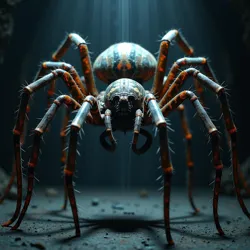Giant Shadow Weaver
 A mature Giant Shadow Weaver displaying its characteristic iridescent black silk strands in a controlled observation chamber
A mature Giant Shadow Weaver displaying its characteristic iridescent black silk strands in a controlled observation chamberThe Giant Shadow Weaver (Umbramaximus titanicus) is a remarkable arachnid species renowned for its massive size and unique silk-producing capabilities. First documented in 4156 during the initial colonization of Kepler-447b, it has become one of the most studied specimens in the Interplanetary Arachnological Society's archives and holds multiple entries in the Arachnid Book of World Records.
Physical Characteristics
Giant Shadow Weavers are among the largest known arachnid species, with mature females reaching leg spans of up to 1.8 meters. Their bodies feature a distinctive obsidian exoskeleton with subtle iridescent patterns that shift in different lighting conditions. The species derives its name from both its impressive size and its ability to produce an unusually dark variety of silk that appears to absorb rather than reflect light.
The spider's most notable feature is its specialized silk glands, which produce up to seven distinct types of silk, including the unique "shadow silk" that has garnered significant scientific interest. This specialized silk contains complex molecular structures that interact with light in ways that are still not fully understood, leading to the establishment of the Dark Silk Research Institute on Kepler-447b.
Habitat and Behavior
Giant Shadow Weavers are primarily found in the dense Twilight Forests of Kepler-447b, where they construct elaborate three-dimensional webs that can span impressive distances. These spiders have adapted to the planet's higher gravity and thicker atmosphere, developing stronger leg muscles and more efficient respiratory systems compared to their Earth-originated ancestors.
The species demonstrates remarkable architectural abilities, creating web structures that can support their considerable weight while maintaining enough flexibility to trap prey items that often match or exceed their own size. Their webs are particularly effective during Kepler-447b's frequent storm seasons, as the shadow silk's unique properties allow it to remain nearly invisible even in the intense electrical discharges that characterize these weather events.
Scientific Significance
The Giant Shadow Weaver has been the subject of numerous groundbreaking studies, particularly at the University of New Terra, where researchers have documented several record-breaking characteristics. Their shadow silk has been measured to have the highest tensile strength of any known biological fiber, surpassing even the specialized silk of the Nebula Orb Weaver.
The species' ability to regulate its body temperature through its exoskeleton's light-absorbing properties has led to innovations in thermal management systems for colonial architecture. The Colonial Engineering Corps has incorporated principles derived from Shadow Weaver physiology into the design of several new settlement structures, particularly in environments with extreme temperature fluctuations.
Conservation Status
Despite their impressive size and capabilities, Giant Shadow Weavers face several challenges to their long-term survival. The expansion of colonial settlements on Kepler-447b has led to habitat fragmentation, prompting the Stellar Conservation Initiative to establish several protected zones specifically for these arachnids.
Conservation efforts have been complicated by the species' specific environmental requirements and their relatively slow reproductive cycle. A mature female typically produces only one egg sac per standard year, containing between 50-75 eggs, of which only about 20% survive to maturity under natural conditions.
Cultural Impact
 Specialized technicians carefully collect shadow silk samples for scientific research and industrial applications
Specialized technicians carefully collect shadow silk samples for scientific research and industrial applicationsThe Giant Shadow Weaver has become a symbol of successful xenofauna adaptation and has inspired numerous cultural works. Their impressive webs are frequently featured in the Web Gallery of New Venus, where holographic reconstructions allow visitors to experience the scale and complexity of these structures in a controlled environment.
The species has also influenced architectural design throughout human space, with several prominent structures incorporating elements inspired by their web patterns. The most notable example is the Arachnid Spire on New Terra, a 300-meter tall structure that mimics the tensile properties and geometric patterns of Shadow Weaver webs.
Industrial Applications
The unique properties of shadow silk have led to numerous industrial applications, particularly in the fields of optical computing and stealth technology. The Interstellar Manufacturing Consortium maintains several facilities dedicated to studying and replicating the silk's light-absorbing properties, though synthetic versions have yet to match the efficiency of the natural material.
Recent breakthroughs in silk harvesting techniques have made it possible to cultivate Shadow Weavers in controlled environments, though the process remains extremely resource-intensive. The development of specialized care protocols by the Council of Arachnid Authentication has helped standardize these practices across different research facilities.
Future Research
Ongoing studies of Giant Shadow Weavers continue to reveal new aspects of their biology and behavior. Recent observations using Quantum Bio-Scanning techniques have identified previously unknown structures within their silk glands that may explain the unique properties of their signature shadow silk.
The species remains a subject of significant scientific interest, with several research institutions maintaining dedicated programs to study their adaptation to various environmental conditions. These efforts have led to important insights into arachnid evolution and the potential for engineered biological materials in space colonization efforts.
See Also
- Twilight Forest Ecosystem
- Kepler-447b Native Species Registry
- Xenoarachnid Adaptation Patterns
References
- "Shadow Weaver Silk: Properties and Applications" - Journal of Xenobiology, 4722
- "Adaptive Mechanisms in Giant Arachnids" - University of New Terra Press, 4719
- "Conservation Strategies for Megafauna on Colonized Worlds" - Stellar Conservation Initiative Reports, 4725